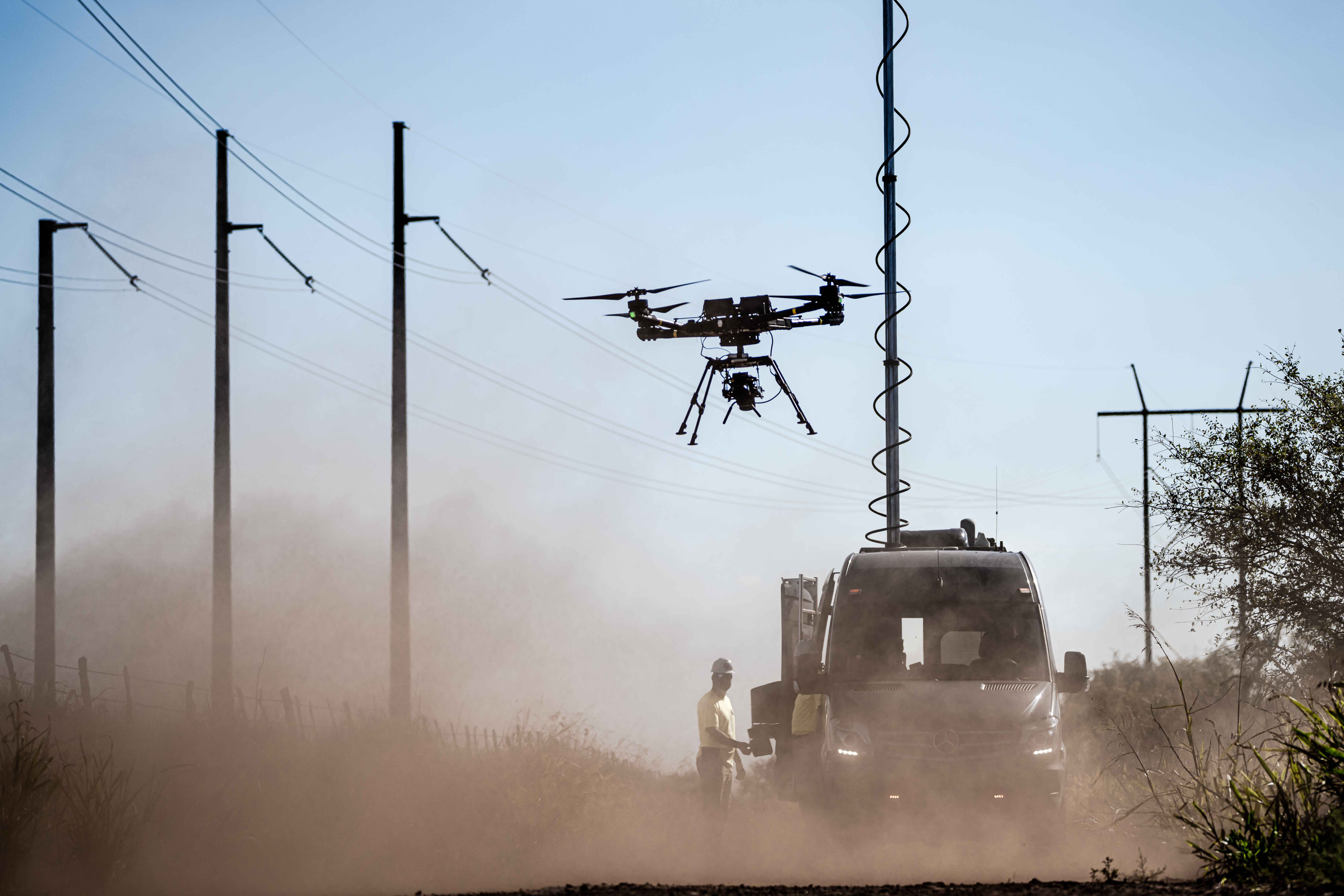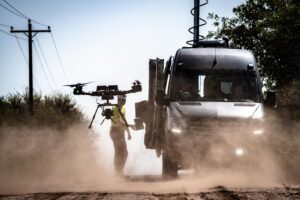 Phoenix Air Unmanned logs 13,000 miles of BVLOS utility line inspections by drone
Phoenix Air Unmanned logs 13,000 miles of BVLOS utility line inspections by drone
By Jim Magill
After about three years of operations, Cartersville, Georgia-based Phoenix Air Unmanned announced it has logged more than 13,000 miles of beyond visual line of sight (BVLOS) flights, inspecting utility transmission lines for Xcel Energy.
Continue reading below, or listen:
The company conducted its inspection flights under Xcel Energy’s certificate of waiver authorizing BVLOS flights without visual observers along the route of flight. The FAA-issued waiver allows for use of unmanned aerial systems (UAS) surveillance spanning Xcel’s 18,000 miles of transmission infrastructure.
In an interview, Will Wheeler, Phoenix’s director of operations, said the flights took place across Xcel’s service territory, which encompasses a broad swath of the U.S. Midwest and Southwest, including the states of Michigan, Wisconsin, Minnesota, North Dakota, South Dakota, Colorado, Oklahoma, Kansas, Texas and New Mexico.

“The flights for beyond visual line of sight actually began in 2019, when Xcel secured their first beyond visual line of sight waiver,” Wheeler said. Since then, the UAS company has flown transmission line inspections every year between the spring and fall months.
Wheeler said exceeding the 13,000-mile mark represents a significant accomplishment for Phoenix and for the commercial drone industry in general. “I don’t know of any other UAS service provider that’s inspected 13,000 miles. I would say that is quite a significant number,” he said.
“For us, it’s being on the leading edge of operational approvals, of being able to operate a drone commercially at scale to where we’re getting into the area of having a similar level of efficiency as a manned aircraft operator.”
Phoenix’s transmission line inspections are typically conducted involving two flight crews operating in a “leap-frog” manner. The first crew launches the drone from the initial take-off location, while the second crew waits at a location about 10 miles down the line. Midway through the flight the first crew hands off control to the second crew, and proceeds down the line to the next flight’s end point, while the second crew lands the drone and prepares it for the next leg of its inspection mission.
Two drones are listed on the waiver. With a battery life of about 30 minutes, the workhorse of the program, a Freefly Systems Alta X, has flown about 10,000 miles of the 13,000 miles of transmission line inspections.
The quad-rotor Freefly Systems Alta X platform equipped with onboard inspection cameras comes in under 55 pounds. Flights are planned utilizing structure locations provided by Xcel Energy as individual flight waypoints. The mission plans are then uploaded to the Alta X before takeoff.
In a statement, Wheeler praised the Alta X for its reliability. “When we started the approval process with the FAA, we were able to come to the table with comprehensive Freefly-provided engineering and test data to supplement the beyond visual line of sight waiver request,” he said. “After accruing 530 flight hours at nine minutes per flight in the real world, aircraft reliability has been proven beyond bench testing.”
For Phoenix’s mission planning purposes, the average flight time is around nine minutes. On average, crews inspect about 40 miles of transmission line per day, with the highest single-day inspection total by a single aircraft being 124 miles.
Wheeler said Phoenix has participated in the FAA’s Aviation Rulemaking Committee’s BVLOS panel and has shared the lessons learned in its years of unmanned transmission line inspection with that body. The company’s work with Excel Energy “has been one of the use cases for developing the next set of beyond visual line side rules for the FAA,” he said.
Other utility companies now are looking at Phoenix’s inspection program with Xcel “to figure out how to scale their own operations and ultimately, create a more reliable, transmission-line grid.”
Stepwise approach to BVLOS approval
Xcel Energy had pursued a stepwise approach toward proving the technology and operational concepts needed to get to the point of being able to conduct repeatable and scalable UAS inspection flights. In 2018 the utility company was granted a site-specific waiver, limited to a 30-mile set of transmission line requiring the use of visual observers.
At the time, Excel worked with industry partners from Phoenix Air Unmanned as well as L3Harris, Northern Plains UAS Test Site and Capital Sciences to build a scalable BVLOS inspection program. The partners held multiple test events along the 30-mile stretch, ultimately validating the concept of operations, and leading to the creation of the datasets that were presented to the FAA to secure the system-wide 18,000-mile approval.
The FAA gave Xcel’s BVLOS flight program a two-year approval in 2019. Following two years of successful operations and an FAA safety assurance assessment, the utility applied for and was granted a duplicate two-year waiver in the fall of 2021.
 Jim Magill is a Houston-based writer with almost a quarter-century of experience covering technical and economic developments in the oil and gas industry. After retiring in December 2019 as a senior editor with S&P Global Platts, Jim began writing about emerging technologies, such as artificial intelligence, robots and drones, and the ways in which they’re contributing to our society. In addition to DroneLife, Jim is a contributor to Forbes.com and his work has appeared in the Houston Chronicle, U.S. News & World Report, and Unmanned Systems, a publication of the Association for Unmanned Vehicle Systems International.
Jim Magill is a Houston-based writer with almost a quarter-century of experience covering technical and economic developments in the oil and gas industry. After retiring in December 2019 as a senior editor with S&P Global Platts, Jim began writing about emerging technologies, such as artificial intelligence, robots and drones, and the ways in which they’re contributing to our society. In addition to DroneLife, Jim is a contributor to Forbes.com and his work has appeared in the Houston Chronicle, U.S. News & World Report, and Unmanned Systems, a publication of the Association for Unmanned Vehicle Systems International.

Miriam McNabb is the Editor-in-Chief of DRONELIFE and CEO of JobForDrones, a professional drone services marketplace, and a fascinated observer of the emerging drone industry and the regulatory environment for drones. Miriam has penned over 3,000 articles focused on the commercial drone space and is an international speaker and recognized figure in the industry. Miriam has a degree from the University of Chicago and over 20 years of experience in high tech sales and marketing for new technologies.
For drone industry consulting or writing, Email Miriam.
TWITTER:@spaldingbarker
Subscribe to DroneLife here.

 Phoenix Air Unmanned logs 13,000 miles of BVLOS utility line inspections by drone
Phoenix Air Unmanned logs 13,000 miles of BVLOS utility line inspections by drone





[…] source […]